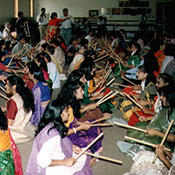 The most important Jain religious observance of the year, Paryushana literally means “abiding” or “coming together.” Lasting either eight or ten days, it is a time of intensive study, reflection, and purification. It culminates with a final day that involves confession and asking for forgiveness.
The most important Jain religious observance of the year, Paryushana literally means “abiding” or “coming together.” Lasting either eight or ten days, it is a time of intensive study, reflection, and purification. It culminates with a final day that involves confession and asking for forgiveness.
... Read more about Paryushana and the Festival of Forgiveness